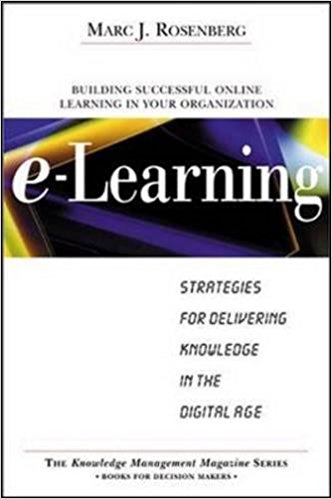e-Learning Summary

5 min read ⌚
 Strategies for Delivering Knowledge in the Digital Age
Strategies for Delivering Knowledge in the Digital Age
We live in times when new technologies leave marks on each aspect of our lives. The Internet has transformed almost all of our experiences, so it is no wonder that the concept of learning started changing as well.
Who Should Read “e-Learning”? And Why?
“e-Learning” is one of the first ones that tackle the topic of online learning practiced in organizations. Marc Rosenberg doesn’t emphasize just the infrastructure challenges firms face when trying to adopt new practices but also spotlights the importance of the organizational culture.
Furthermore, Rosenberg explains the issues a company will most likely encounter on the path of building a culture of learning. Accordingly, he presents the need to balance between matters connected to the structure of e-learning and issues concerned with its implementation.
About Marc J. Rosenberg
 Marc J. Rosenberg. Ph.D. is a principal with DiamondCluster Global, a business planning, and innovation arrangements firm, where he specializes in information administration and e-learning technique.
Marc J. Rosenberg. Ph.D. is a principal with DiamondCluster Global, a business planning, and innovation arrangements firm, where he specializes in information administration and e-learning technique.
Notwithstanding his Ph.D. in Instructional Plan, Rosenberg holds degrees in communications and marketing. He is the writer of more than 30 articles in this field, and at the moment lives in Hillsborough, New Jersey.
A profoundly respected moderator, he has talked at the White House and more than 200 expert and business gatherings.
“e-Learning Summary”
No one can ignore the power and the potential of the Internet. However, even though businesses have to incorporate it in their experience, they cannot fixate only on technology.
No matter how hard to try to be up to date with all the new ways of delivering information, it won’t give any results until you enable a learning culture in your company.
The environment is changing at a fast pace, so it is vital for companies to share information quickly and efficiently. The problem nowadays has shifted from opening up to the possibility of online learning – to the ways you can do it.
In the new century, the principal competitive weapon is the education of the employees. In a dynamic society in which changes are a normal phenomenon, being able to learn is the only thing that you can use to keep pace.
The new age asks for a shift from training to performance, and a transformation of learning from paper to online, from cycle time to real time. Businesses have to continually try to build new bridges to their ultimate goal: improving learning efficiency.
However, as we already stated, none of these evolutionary practices of the company are possible without creating a positive learning climate on the inside. Managers and leaders have to understand that learning is no longer optional, but crucial.
Moreover, they must empower employees to participate in the process. They should give employees access to information and knowledge. Or, in other words, they have to make learning available, make time for it, and actively encourage it.
Now that we explained why creating an appropriate organizational culture that encourages learning, it is time to move on to defining e-learning. E-learning is a collective name for a number of channels through which knowledge can be distributed.
Three basic principles create the base for e-learning. First, it is networked. Second, users convey it via the Internet. And third, it puts the spotlight on learning in the broadest sense.
The Internet allows knowledge and information to be displayed and updated instantly, so it enables e-learning to surpass the limits of traditional education and training. Apart from delivering timely content, e-learning is flexible, easily transferred, it reduces costs and increases the firm’s responsiveness.
Furthermore, we shouldn’t forget to underline its interactivity and immediacy. E-learning can be used to create authentic business simulations and provide the means for practical training.
As can be seen, defining e-learning and studying its concepts and forms is only the first part of the process.
The next step is preparing your organization by addressing the infrastructure. Also, you should focus on educating your management on the positive aspects of e-learning, and how it can help the company.
Cultivating a culture that allows changes and improvements, is vital for your company’s prosperity.
Key Lessons from “e-Learning”
1. Learning versus training
2. The needs of business
3. Forms of e-learning
Learning versus training
In times when we swim in an endless sea of information, the volume of things that you need to learn is shattering. Old ways of obtaining knowledge and competencies, and of how they communicate it to other workers, are quickly getting worthless in the face of new advancements.
Companies need to differentiate between learning and training.
Training is the way in which you pass on data. Learning is the means by which you process data into actual knowledge.
From a business point of view, the coveted outcome of education is better performance. Training and guidelines, on the other hand, shape learning into the wanted form.
The needs of business
Organizations need to create an open culture, give the correct data and the required technology, to be able to meet the workers’ learning needs. Despite the fact that content is an object of continual change, the accurate information has to be conveyed timely and correctly.
Each employee needs a personalized learning design, which can only exist in a culture that supports free, open flow of data. Empowering a learning culture is a fundamental step. A few people consider e-learning as a simple transfer of classroom instruction to an online platform.
However, this way of thinking is going to keep businesses from prosperity.
Forms of e-learning
Two parts create e-Learning: online training and classroom learning. To be able to create a balanced approach to using both, you should ask yourself if there is a way to enhance classroom learning with its online counterpart. Think of how you should sequence them.
When used jointly, these approaches gain more power and deliver more knowledge.
Like this summary? We’d Like to invite you to download our free 12 min app, for more amazing summaries and audiobooks.
“e-Learning” Quotes
When the rate of change outside exceeds the rate of change inside, the end is in sight. Share on X To leverage the potential of e-learning technology for sustained, beneficial change, a sound business and people-centered strategy is essential. Share on X The exponential growth of information that characterizes modern business makes the need for learning more important than ever. Share on X Do you buy online courses by the bag full without really knowing what you’re getting? Are e-learning funds always the first to be cut during a financial crisis? These are pretty obvious symptoms of an ineffective strategy. Share on XOur Critical Review
This practical book is a much-needed manual for executives who are on the verge of accepting e-learning as a practice in their companies’ culture.








